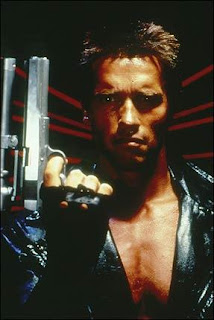Friday, October 1, 2010
The Terminator
Give him a bloated budget and he’ll make a bloated movie, but when he had to be creative on the cheap, James Cameron was brilliant—and never more so than in The Terminator, the first feature he directed. (He’s listed as codirector on Piranha Part Two but was replaced after two weeks, so this is the real deal, the first to declare itself A James Cameron Film in the opening credits.)
Most of the acting is pretty wooden, including Linda Hamilton’s as Sarah Connor, the human lead (the real star, of course, is the killing machine who’s come back from the future to terminate her). But Cameron and his cowriter/producer (and about-to-be wife) Gale Ann Hurd maintain the tension with the assurance of old pros, setting up the generally bland, early-decline capitalism of Sarah’s pleasant-enough present only to rip it open with the naked arrival of the amazing Arnold. The Terminator was the role of Schwarzenneger’s career, making perfect use of his inhuman physique, Teutonic accent, rigid posture, and even stiffer line readings. From the moment that still-naked cyborg shoves its hand into a punk’s chest and pulls out his beating heart, we’re in for a steady succession of seminal images (the Terminator driving through the door of the police station) and vivid sight gags (the toy truck the camera focuses on in the gutter as the Terminator pulls up, smushing it flat).
Both the story and its main character were so startlingly original that they still resonate after more than 25 years of riffs and ripoffs, including the Transformers series and the progressively less interesting Terminator sequels. The Terminator is one of the great horror movie monsters of all time, as focused as his Uzi’s laser sight and as hard to keep down as Halloween’s Mike Myers. It’s scary enough to watch him stalk past cowering people or nervously barking dogs, but when the filmmakers switch to his point of view, showing his potential targets through an infrared sensor with streams of data scrolling down the sides, you realize just how screwed they are. This is no product of a damaged childhood or sociopath with a screw loose: it’s a perfectly calibrated killing machine with every screw right where it’s supposed to be. And that image resonates like a Japanese gong because, like all good movie monsters, the Terminator personifies one of our shared primal terrors: in this case, fear of where our rush to develop artificial intelligence and technologically sophisticated war machines may be taking us. As usual, Cameron flip-flops between fetishizing totally awesome killing machines and delivering earnest anti-war messages. His vision of a future in which computers are the dominant species remains a potent worst-case scenario, and his unmanned predator drones, which were still a sci-fi head rush in 1984, are currently wreaking havoc in Afghanistan.
And as in John Carpenter’s Halloween and the Alien franchise Cameron was soon to contribute to—and in precious few non-genre movies of the time—there’s a great female role at the center of this story. Starting out patronized and apologetic and slowly learning to appreciate her own power and skills, Sarah is a girl-power twist on the generally male revenge-of-the-nerd template.
Cameron told Wired that greatest challenge of the movie for him—and, apparently, the greatest thrill—was figuring out how to create a humanoid hit man with “a true robotic endoskeleton.” After months of development, Cameron and Stan Winston developed models detailed enough to make for eerie scenes like the one where the Terminator repairs himself in a seedy hotel room, revealing the machinery beneath his skin. The special effects were amazing at the time, but they sometimes look a little crude, even in the low lighting Cameron presumably used to mask imperfections. When the camera gets close enough to the silicone, clay and plaster casts of Schwarzenneger’s face and arm to show how plastic they look, or when stop-motion makes that robotic endoskeleton move as haltingly as a Harryhausen monster after its flesh is burned off, the Terminator can look as hokey as those rivetingly ridiculous 80s hairstyles. The flashbacks to the future are a little corny, too, between the unconvincing melodrama of the human dugout and the insufficiently scary hunter/killer machines: It’s hard for eyes spoiled by 21st-century CGI to ignore the wobble in the flying drones or the early-video-game look of the intersecting laser beams they throw down. But then, rough edges like that are part what make great B movies feel so alive.
The moral to this story may be that too much freedom isn’t always good for a filmmaker. If Cameron had less cash and more collaboration on his scripts, maybe he’d still be making movies this good.
Written for The L Magazine
Subscribe to:
Post Comments (Atom)

No comments:
Post a Comment